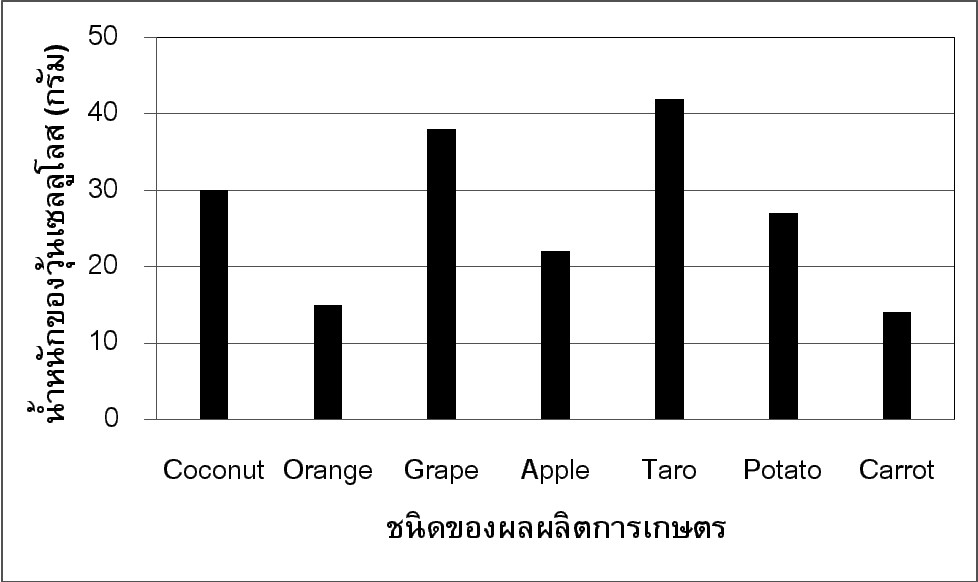การผลิตเซลลูโลสจากแบคทีเรีย Acetobacter xylinum TISTR 086 โดยใช้ผลผลิตทางการเกษตรเป็นแหล่งคาร์บอน
Main Article Content
Abstract
Wichitta Maichan, Pichamol Kammanglakan, Suwanna Sudpruek, Kullanan Prudprom, Chutima Anchana, Jantima Pongpanich, and Surasak Laloknam
รับบทความ: 15 ตุลาคม 2555; ยอมรับตีพิมพ์: 26 พฤศจิกายน 2555
บทคัดย่อ
งานวิจัยนี้มีวัตถุประสงค์เพื่อผลิตเซลลูโลสจากแบคทีเรีย Acetobacter xylinum TISTR086 โดยใช้ผลผลิตทางการเกษตรเป็นแหล่งคาร์บอน ได้แก่ แอปเปิ้ล องุ่น ส้ม เผือก แครอท และมันฝรั่ง และใช้น้ำมะพร้าวเป็นตัวควบคุม โดยเริ่มจากการหาปริมาณน้ำตาลรีดิวซ์ในผลผลิตทางการเกษตรตัวอย่างทำปฏิกิริยากับสารละลายกรดไดไนโตรซาลิก พบว่า ผลผลิตทางการเกษตรที่ให้น้ำตาลรีดิวซ์สูงสุด 3 ลำดับแรก ได้แก่ แอปเปิ้ล เผือก และมันฝรั่ง จากนั้นนำผลผลิตทั้งหมดไปหมักกับ Acetobacter xylinum TISTR086 เพื่อผลิตเซลลูโลสโดยแปรผันปริมาณน้ำตาลรีดิวซ์ร้อยละ 0 – 3 โดยน้ำหนักต่อปริมาตร พบว่า ผลิตภัณฑ์ที่ให้น้ำหนักเซลลูโลสสูงสุด ได้แก่ เผือก องุ่น และมะพร้าว ตามลำดับ ตัวอย่างจากเผือกที่ความเข้มข้นของน้ำตาลรีดิวซ์ร้อยละ 1 โดยน้ำหนักต่อปริมาตรให้ผลผลิตสูงที่สุด เซลลูโลสที่อยู่ในรูปวุ้นสวรรค์มีความชื้นร้อยละ 90 โดยน้ำหนักต่อน้ำหนัก ดังนั้นจึงอธิบายได้ว่า ผลผลิตทางการเกษตรสามารถนำมาใช้ในการผลิตเซลลูโลสได้
คำสำคัญ: เซลลูโลสจากแบคทีเรีย ผลผลิตทางการเกษตร Acetobacter xylinum TISTR086
Abstract
This research aimed at producing gelatinous bacterial cellulose from Acetobacter xylinum TISTR086 using agricultural products as carbon sources. Agricultural products were apple, grape and carrot, taro, carrot and potato, and coconut milk was used as a control. All samples were determined reducing sugar contents using dinitrosalic acid method. The result showed that three agricultural products with highest reducing sugar were apple juice, taro and potato, respectively. All agricultural products with a rage of 0 – 3 %(w/v) reducing sugar were fermented with Acetobacter xylinum TISTR086 to produce gelatinous bacterial cellulose. The finding indicated that the product giving the highest cellulose weight was taro, following by grape and coconut, respectively. The taro sample with 1%(w/v) of reducing sugar gave the highest cellulose weight. The fresh gelatinous bacterial cellulose had 90% moisture content. Therefore, the agricultural product is able to use as carbon source of cellulose production.
Keywords: Bacterial cellulose, Agricultural product, Acetobacter xylinum TISTR086
Downloads
Article Details

This work is licensed under a Creative Commons Attribution-NonCommercial 4.0 International License.
References
กิ่งแก้ว เจริญพรสุข. (2547). การผลิตวุ้นสวรรค์จากเวย์. วารสารพระจอมเกล้าลาดกระบัง 12 (1): 36-41.
จารุวรรณ์ ศิริพรรณพร ปราโมทย์ ธรรมรัตน์ สิริพร สธน-เสาวภาคย์ สร้อยทอง สายหยุดทอง กาญจนิจ วาจนะ-วินิจ ศรีเมือง มาลีหวล สมคิด ธรรมรัตน์ และ Dinh-Ngoc-Loan. (2544). ปัจจัยที่มีผลต่อการผลิตวุ้นสวรรค์จากน้ำกะทิ. วารสารอาหาร 31(3): 166-173.
ปิยรัชช์ กุลเมธี. (2555). การผลิตวุ้นมะพร้าว (วุ้นสวรรค์). เอกสารประกอบการสอนวิชาปฏิบัติการจุลชีววิทยาสำหรับอุตสาหกรรมเกษตร. คณะอุตสาหกรรมเกษตร มหาวิทยาลัยเทคโนโลยีพระจอมเกล้าพระนครเหนือ.
วราวุฒิ ครูส่ง กรวิกา สุขศรีวงษ์ และปนัดดา พวงเกษม. (2536). การผลิตเซลลูโลสจากเชื้อ Acetobacter xylinum ในน้ำหางนม. วารสารพระจอมเกล้าลาดกระบัง. 1(1): 46–60.
ศิริพงษ์ เปรมจิต. (2542). การผลิตเซลลูโลสจากกากน้ำตาลโดย Acetobacter xylinum ATCC10245. วารสารมหาวิทยาลัยนเรศวร 7(2): 18–32.
สถาบันค้นคว้าและพัฒนาผลิตภัณฑ์อาหาร. (2545). ผลิต-ภัณฑ์วุ้นมะพร้าว/วุ้นสับปะรด. เอกสารประกอบการอบรมเชิงปฏิบัติการ. กรุงเทพฯ: มหาวิทยาลัยเกษตรศาสตร์.
สมปอง ใจดีเฉย. (2546). การผลิตวุ้นมะพร้าวจากส่วนของผลไม้ที่ไม่ใช้แล้วโดย Acetobacter xylinum. ศึกษาศาสตร์ องครักษ์ 2(2): 105–116.
สันทัด ศิริอนันต์ไพบูลย์. (2544). เทคโนโลยีชีวภาพใกล้ตัว. กรุงเทพฯ: สถาบันวิทยาศาสตร์และเทคโนโลยีแห่งประเทศไทย.
สุเมธ ตันตระเธียร และวราวุฒิ ครูส่ง. (2537). วุ้นมะพร้าว. วารสารวิทยาศาสตร์ 48(6): 360-366.
สุรศักดิ์ ละลอกน้ำ. (2554). สารชีวโมเลกุล ตอนที่ 1 คาร์โบไฮเดรต. เอกสารประกอบการสอนวิชาชีววิทยาสำหรับครูวิทยาศาสตร์ ตอนที่ 1. คณะวิทยาศาสตร์ มหาวิทยาลัยศรีนครินทรวิโรฒ.
Forang, E.R., Anderson, S.M., and Cannon, R.E. (1989). Synthetic medium for Acetobacter xylinum that can be used for isolation of auxotrophic mutants and study of cellulose biosynthesis. Appl. Environ. Microbiol. 55: 1317–1319.
Iguchi, M., Yamanaka, S., and Budhiono, A. (2000). Bacterial cellulose-masterpiece of nature’s arts. J. Mat. Sci. 35: 261-270.
Ishikawa, M., Matsuoka, M., Tsuchida, T., and Yoshinaga, F. (1995). Increase in cellulose production by sulfa-guanidine-resistant mutants derived from Acetobacter xylinum subsp. sucrofermentans. Biosci. Bio-technol. Biochem. 59(12): 2259–2262.
Masaoka, S., Ohe, T., and Sakota, N. (1993). Production of cellulose from glucose by Acetobacter xylinum. J. Ferment. Bioeng. 75(1): 18–22.
Ross, P., Raphae, M., and Moshe, B. (1991). Cellulose biosynthesis and function in bacteria. Microbiol. Rev. 55: 35–38.
Vandamme, E. J., de Baets, S., Vanbaelen, A., Joris, K., and de Wulf, P. (1988). Improved production of bacterial cellulose and its application potential. Polym. Degrad. Stab. 59: 93–99.
Wen, Z., Liao, W., and Chen, S. (2005). Production of cellulose by Trichoderma reesei from dairy manure. Biores. Technol. 96: 491-499.
